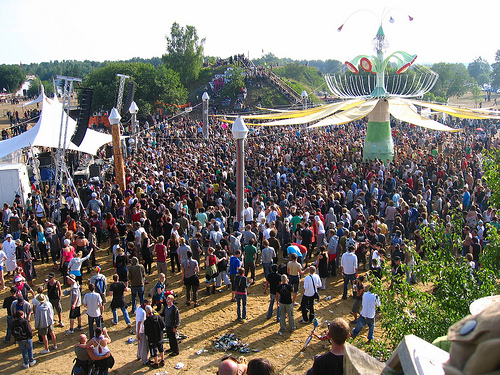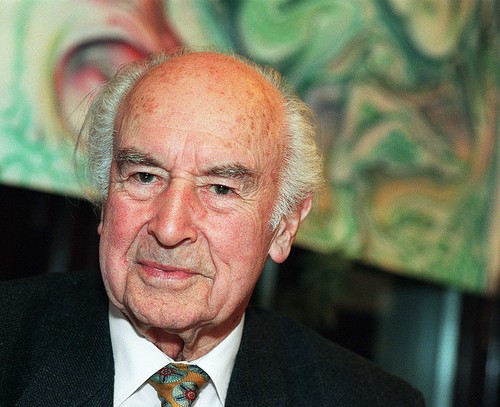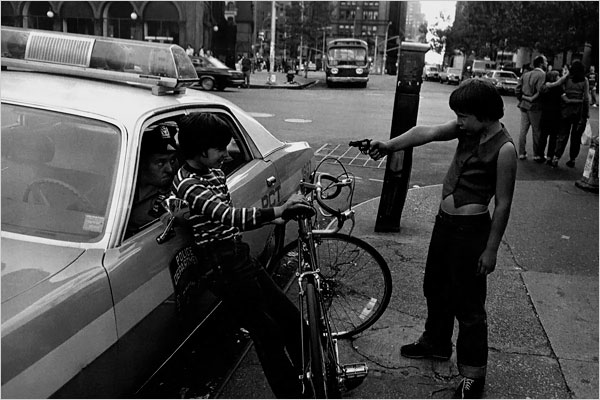Food that takes the shape of its container
one in a series of food that takes the shape of its container
Via Marcus Trimble at Super Colossal.
Give Us Today Our Daily Terror
Exact copy of Hitchcock’s 1963 film The Birds from which all birds have been removed
Single channel video, color, 119 minutes
Via Marcus Trimble at Super Colossal.
Fusion Festival
End of June - every year the same procedure… On a former Russian military airfield in the middle of nowhere in the fields of northern Germany FUSION arises, the biggest holiday and party camp all over the place. 4 days of holiday communism is the motto and as such the programme covers it all.
Where’s Waldo?:
Photo by phogel
Good overview of the camp and my favorite stage:
Rumor was 40k people by sunday.
Remute midnight friday:
Whoa:
Sunday morning, DJ Koze:
Heavyweight physics prof weighs into climate/energy scrap
Lewis Page in The Register:
Professor David J C MacKay of the Cambridge University Department of Physics holds a PhD in computation from Cal Tech and a starred first in Physics, so we can take it that he knows his numbers. And, as he points out, numbers are typically lacking in current discussion around carbon emissions and energy use.
MacKay tells The Reg that he was first drawn into this field by the constant suggestion — from the Beeb, parts of the government etc — that we can seriously impact our personal energy consumption by doing such things as turning our TVs off standby or unplugging our mobile-phone chargers.
Anyone with even a slight grasp of energy units should know that this is madness. Skipping one bath saves a much energy as leaving your TV off standby for over six months. People who wash regularly, wear clean clothes, consume hot food or drink, use powered transport of any kind and live in warm houses have no need to worry about the energy they use to power their electronics; it’s insignificant compared to the other things.
The article goes on to summarize some of the solution scenarios MacKay worked out for the UK, and as you would expect nuclear is the only one that is close to achievable.
Via Arts & Letters Daily.
Beautiful Machinery
Sculptor and engineer Arthur Ganson talks about his work -- kinetic art that explores deep philosophical ideas and is gee-whiz fun to look at.
Via Wohba!.
The World in His Mail Box: Eulogy for Tony Schwartz
Posted by Doug Schulkind to WFMU's Beware of the Blog.
Recorded sound had no greater friend than Tony Schwartz, the audio documentarian, advertising guru, media consultant, and exalted citizen of the aural universe, who passed away Saturday a few months shy of his 85th birthday. He'll be forever linked to his best-known work—the infamous "Daisy" ad from Lyndon Johnson's 1964 re-election campaign—but to many, Schwartz is beloved for sharing with the world his lifelong infatuation with the musicality of prosaic sounds.
And Doug posted some great clips from his albums, go listen.
"Bruce Schneier and the King of the Crabs"
ORAL HISTORY INTERVIEW WITH SAMUEL BRONKOWSKI AT HIS HOME IN TUCSON RESERVATION, BY GALEN PARR 5.1, DATED JUNE 17, 2078SB: This one’s called, “Bruce Schneier and the King of the Crabs.” It mostly must have really happened, too – it’s how we lost Barbados, or Bermuda, or some island down there anyway.
GP: I don’t believe we have that one on file. But it would probably be Barbados, because that’s still a restricted zone. I don’t know why. I thought it was nuclear, though.
SB: Well, may well be I can shed some light on that. I personally don’t think this actually happened to Bruce Schneier, but that’s the way it was told to me, and it’s still worth telling. Story goes, ol’ Bruce Schneier was vacationing on Barbados with his dog once. And they’d go out walking on the beach, as men and dogs often do.
Via Schneier on Security.
The Scene
Posted by Marcus Estes to WFMU's Beware of the Blog.
The Scene was a television show aired in Detroit on WGPR, the first black-owned TV station in America. From 1975 to 1987 the show served as black culture's reinvention of the "dance show" format - and looking back on these amazing tapes now it hurts to understand why it remained a purely local phenomenon.
While white America was up to god knows what on American Bandstand aired Saturday mornings across America, The Scene was publicizing and helping give birth to Detroit Techno
Check the clip.
Richard Feynman and the Connection Machine
W. Daniel Hillis for Physics Today at The Long Now Foundation:
One day when I was having lunch with Richard Feynman, I mentioned to him that I was planning to start a company to build a parallel computer with a million processors. His reaction was unequivocal, "That is positively the dopiest idea I ever heard." For Richard a crazy idea was an opportunity to either prove it wrong or prove it right. Either way, he was interested. By the end of lunch he had agreed to spend the summer working at the company.
Via Daring Fireball.
Could an Acid Trip Cure Your OCD?
Linda Marsa in Discover Magazine:
At a handful of sites across the country, after a four-decade hiatus, psychedelic research is undergoing a quiet renaissance, thanks to scientists like Charles Grob who are revisiting the powerful mind-altering drugs of the 1960s in hopes of making them part of our therapeutic arsenal. Hallucinogens such as psilocybin, MDMA (better known as Ecstasy), and the most controversial of them all, LSD, are being tested as treatments for maladies that modern medicine has done little to assuage, such as post-traumatic stress disorder, drug dependency, obsessive-compulsive disorder, cluster headaches, and the emotional suffering of people with a terminal illness.
While Grob’s study is not complete—he has tested 11 out of a projected 12 volunteers—patients seemed to have positive experiences. “No one had a bad trip, and most derived some benefit,” he says. “It lowered their anxiety, improved their mood and disposition, and imbued them with a greater acceptance of their situation and capacity to live in the moment and appreciate each day.”
This is a fairly well written article that covers the basics of past psychedelics research, and the current minimal studies that are going on now. I have archived the article here because Discover's site is completely broken in Safari, and hideously unusable in Firefox.
Does Time Run Backward in Other Universes?
A different theory than the earlier posted Loop Quantum Gravity ("quantum bounce"), though this article does touch on that idea in it's sum up of previous research.
Sean M. Carroll in Scientific American Magazine:
In the presence of dark energy, empty space is not completely empty. Fluctuations of quantum fields give rise to a very low temperature—enormously lower than the temperature of today’s universe but nonetheless not quite absolute zero. All quantum fields experience occasional thermal fluctuations in such a universe. That means it is not perfectly quiescent; if we wait long enough, individual particles and even substantial collections of particles will fluctuate into existence, only to once again disperse into the vacuum. (These are real particles, as opposed to the short-lived “virtual” particles that empty space contains even in the absence of dark energy.)
Among the things that can fluctuate into existence are small patches of ultradense dark energy. If conditions are just right, that patch can undergo inflation and pinch off to form a separate universe all its own—a baby universe. Our universe may be the offspring of some other universe.
Superficially, this scenario bears some resemblance to the standard account of inflation. There, too, we posit that a patch of ultradense dark energy arises by chance, igniting inflation. The difference is the nature of the starting conditions. In the standard account, the patch arose in a wildly fluctuating universe, in which the vast bulk of fluctuations produced nothing resembling inflation. It would seem to be much more likely for the universe to fluctuate straight into a hot big bang, bypassing the inflationary stage altogether. Indeed, as far as entropy is concerned, it would be even more likely for the universe to fluctuate straight into the configuration we see today, bypassing the past 14 billion years of cosmic evolution.
In our new scenario, the preexisting universe was never randomly fluctuating; it was in a very specific state: empty space. What this theory claims—and what remains to be proved—is that the most likely way to create universes like ours from such a preexisting state is to go through a period of inflation, rather than fluctuating there directly. Our universe, in other words, is a fluctuation but not a random one.
Emit fo Worra
This scenario, proposed in 2004 by Jennifer Chen of the University of Chicago and me, provides a provocative solution to the origin of time asymmetry in our observable universe: we see only a tiny patch of the big picture, and this larger arena is fully time-symmetric. Entropy can increase without limit through the creation of new baby universes.Best of all, this story can be told backward and forward in time. Imagine that we start with empty space at some particular moment and watch it evolve into the future and into the past. (It goes both ways because we are not presuming a unidirectional arrow of time.) Baby universes fluctuate into existence in both directions of time, eventually emptying out and giving birth to babies of their own. On ultralarge scales, such a multiverse would look statistically symmetric with respect to time—both the past and the future would feature new universes fluctuating into life and proliferating without bound. Each of them would experience an arrow of time, but half would have an arrow that was reversed with respect to that in the others.
The idea of a universe with a backward arrow of time might seem alarming. If we met someone from such a universe, would they remember the future? Happily, there is no danger of such a rendezvous. In the scenario we are describing, the only places where time seems to run backward are enormously far back in our past—long before our big bang. In between is a broad expanse of universe in which time does not seem to run at all; almost no matter exists, and entropy does not evolve. Any beings who lived in one of these time-reversed regions would not be born old and die young—or anything else out of the ordinary. To them, time would flow in a completely conventional fashion. It is only when comparing their universe to ours that anything seems out of the ordinary—our past is their future, and vice versa. But such a comparison is purely hypothetical, as we cannot get there and they cannot come here.
Via Arts & Letters Daily.
Why I had to lie to my dying mother
American writer Susan Sontag was terrified of death. She beat cancer in the 1970s, and again in the 1990s, but third time around she wasn't so lucky. In a tender account of her final illness, her son David Rieff recalls how he colluded with his mother's fantasy that she wasn't dying - and what this ultimately cost him after she had gone.
Via Arts & Letters Daily.
YouTomb
YouTomb is a research project by MIT Free Culture that tracks videos taken down from YouTube for alleged copyright violation.More specifically, YouTomb continually monitors the most popular videos on YouTube for copyright-related takedowns. Any information available in the metadata is retained, including who issued the complaint and how long the video was up before takedown. The goal of the project is to identify how YouTube recognizes potential copyright violations as well as to aggregate mistakes made by the algorithm.
Via Justin
Bizarre bouts of self-expression
Tomoko Otake for The Japan Times
Nearly 300 spectators cheered wildly as disco music blared. A spotlight picked out two fighters approaching the ring to kick off a puroresu (prowrestling) event held recently in a Tokyo town hall. Then a female MC announced, in a startlingly high-pitched voice: "In the blue corner, E.T.! In the red corner, Arm Bomb Fujiwara!" Both wrestlers were physically handicapped and had to be helped or lifted into the ring. But when the starting bell rang, the men -- both of them sitting and rolling around on the canvas -- began punching each other with all the power and accuracy they could muster.
Blows landed thick and fast, and the crowd roared. Then Arm Bomb Fujiwara got his arm round E.T.'s neck and began to throttle him. As E.T.'s face reddened to puce and he started shaking, the referee called a halt to the bout and declared a win for Arm Bomb -- who raised his fist high as the crowd laughed and shrieked.
That night, many of the dozen disabled wrestlers from the Doglegs group that staged the show in western Tokyo's Shimokitazawa district looked truly fired up and fearless. In melodramatic contrast, the few able-bodied participants were wimps, including one going by the name of "Mushikera Goro (Worthless Goro)" who, according to the program, was a hikikomori (long-term stay-at-home recluse) with a big-time Oedipus complex. He lost out to 41-year-old "Anchi-teze" (Antithesis) Kitajima, the broad-shouldered nondisabled man who is also Doglegs' leader.
But why stage contests in which one or both participants are so clearly disadvantaged? What is it all about?
"That's our intention -- to make people think," said Doglegs' leader and cofounder Kitajima -- real name, Yukinori Kitajima -- who makes a living not from running Doglegs but from writing fiction and computer-game scenarios.
Speaking after the two-hour event had ended, the father of two young girls said that over the past 15 years the group has performed around 70 times all over Japan, and once in South Korea. Then he explained: "We don't want to show something for people to simply laugh at and walk away. You might get a laugh out of our matches at times, but we also want people to wonder what this all means. We want to give people a nasty aftertaste."
See also Doglegs' homepage (Japanese), some videos on youtube.
Via NoneMoreNegative
Dynamic Languages Strike Back
Some guys at Stanford invited me to speak at their EE Computer Systems Colloquium last week. Pretty cool, eh? It was quite an honor. I wound up giving a talk on dynamic languages: the tools, the performance, the history, the religion, everything. It was a lot of fun, and it went over surprisingly well, all things considered.
Via Tim Bray.
LSD Inventor Albert Hofmann Dies at 102
Thomas H. Maugh II | Los Angeles Times Staff Writer:
But Hofmann's life had already been altered. LSD and the other psychoactive drugs "changed my life, insofar as they provided me with a new concept about what reality is," he said. "Before, I had believed there was only one reality: the reality of everyday life.
"Under LSD, however, I entered into realities which were as real and even more real than the one of everyday." He also "became aware of the wonder of creation, the magnificence of nature and of the plant and animal kingdom. I became very sensitive to what will happen to all this and all of us."
Pencil carvings by Mizuta Tasogare and Kato Jado
Here is the artists’ page, and here is a blog post which has helpfully put most of them on one page for easy viewing.
Via Super Colossal.
Through Weegee’s Lens
Niko Koppel at The New York Times.
BACK in the 1970s, a gutsy blonde named Jill Freedman armed with a battered Leica M4 and an eye for the offbeat trained her lens on the spirited characters and gritty sidewalks of a now-extinct city.
Side note: WTF does nyt think it is doing with the video features? You can’t have your average print journalist produce a video (though they seem to do fine moving to the radio docu style as seen in the “audio slide shows”).







